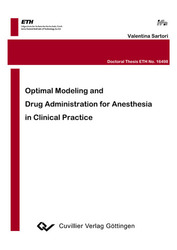| Departments | |
|---|---|
| Book Series (96) |
1378
|
| Nachhaltigkeit |
3
|
| Gesundheitswesen |
1
|
| Humanities |
2364
|
| Natural Sciences |
5406
|
| Mathematics | 229 |
| Informatics | 319 |
| Physics | 980 |
| Chemistry | 1363 |
| Geosciences | 131 |
| Human medicine | 243 |
| Stomatology | 10 |
| Veterinary medicine | 108 |
| Pharmacy | 147 |
| Biology | 835 |
| Biochemistry, molecular biology, gene technology | 121 |
| Biophysics | 25 |
| Domestic and nutritional science | 45 |
| Agricultural science | 1004 |
| Forest science | 201 |
| Horticultural science | 20 |
| Environmental research, ecology and landscape conservation | 148 |
| Engineering |
1793
|
| Common |
98
|
|
Leitlinien Unfallchirurgie
5. Auflage bestellen |
|
Advanced Search
Optimal Modeling and Drug Administration for Anesthesia in Clinical Practice (English shop)
Valentina Sartori (Author)Preview
Table of Contents, Datei (30 KB)
Extract, Datei (55 KB)
Considering the advantages obtained through the use of mathematical models in the clinical practice of anesthesia, this thesis proposes strategies for optimal parameter estimation of such models and for the consequent modelbased definition of an ideal drug administration. The goals of the work are summarized in Chapter 1. For an easy understanding of the topics, the basic concepts of pharmacokinetic and pharmacodynamic are defined and described in Chapter 2. In Chapter 3 we present two revolutionary methods for the optimal administration of multiple drugs for post-operative pain management. The first method bases on a black-box algorithm, which uses the information retrieved from a group of combinations of the drugs of interest to identify new combinations to be tested to move towards the optimal analgesic point. The algorithm has been successfully applied in clinical practice. The second methods is based on the development of a mathematical model describing the relationship between dose and effect for n drugs, as a function of their interactions. From the analysis of the model, guidelines for drug administration ensuring maximal benefits for the patient can be extracted. In Chapter 4 we exploit the problem of large inter-patient variability in terms of response to drug administration. Such variability is associated to the incapability of pharmacokinetic and pharmacodynamic population models to correctly predict the response of the single individual. To compensate for that, we propose and test a strategy for the on-line individual identification of some of the model parameters.
| ISBN-13 (Printausgabe) | 3865379664 |
| ISBN-13 (Hard Copy) | 9783865379665 |
| ISBN-13 (eBook) | 9783736919662 |
| Language | English |
| Page Number | 180 |
| Edition | 1 |
| Volume | 0 |
| Publication Place | Göttingen |
| Place of Dissertation | Zürich |
| Publication Date | 2006-07-30 |
| General Categorization | Dissertation |
| Departments |
Human medicine
Biology |








